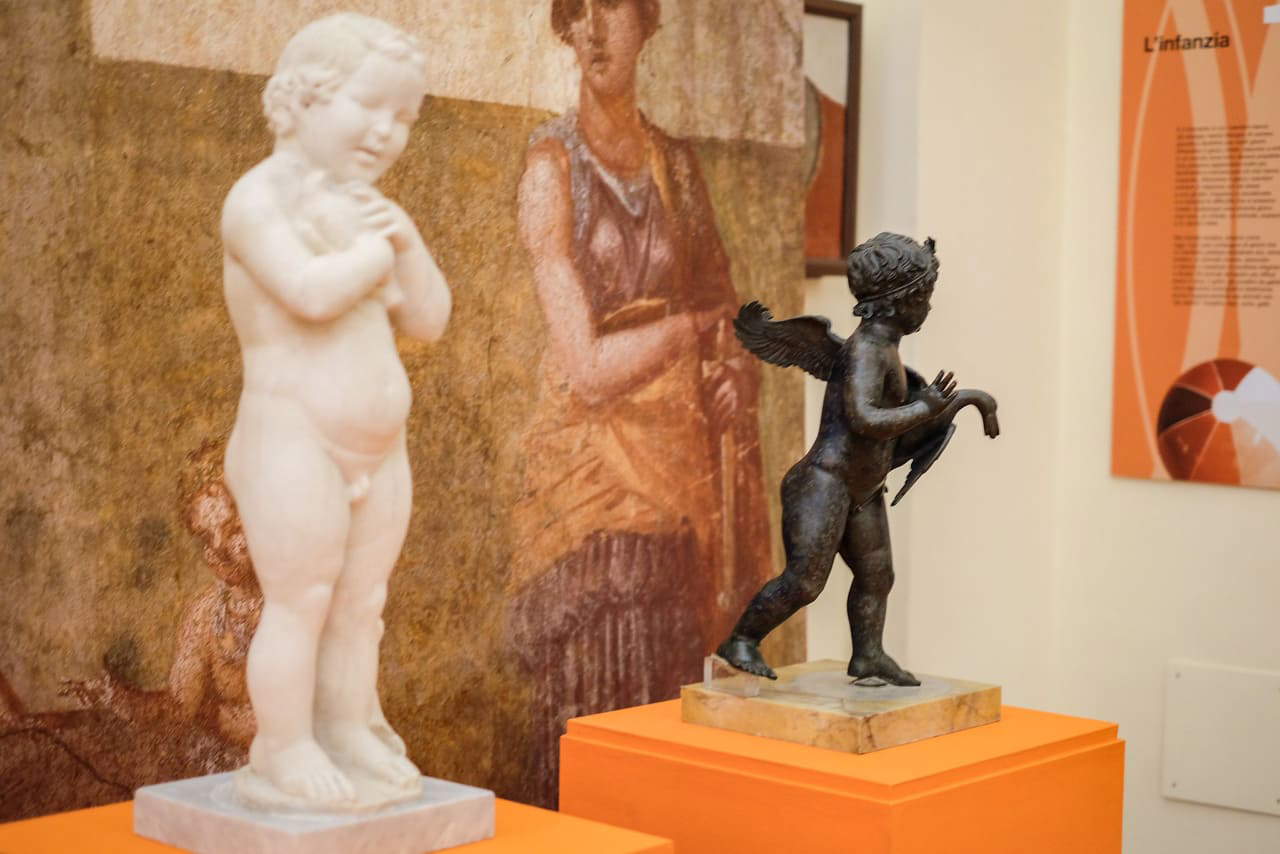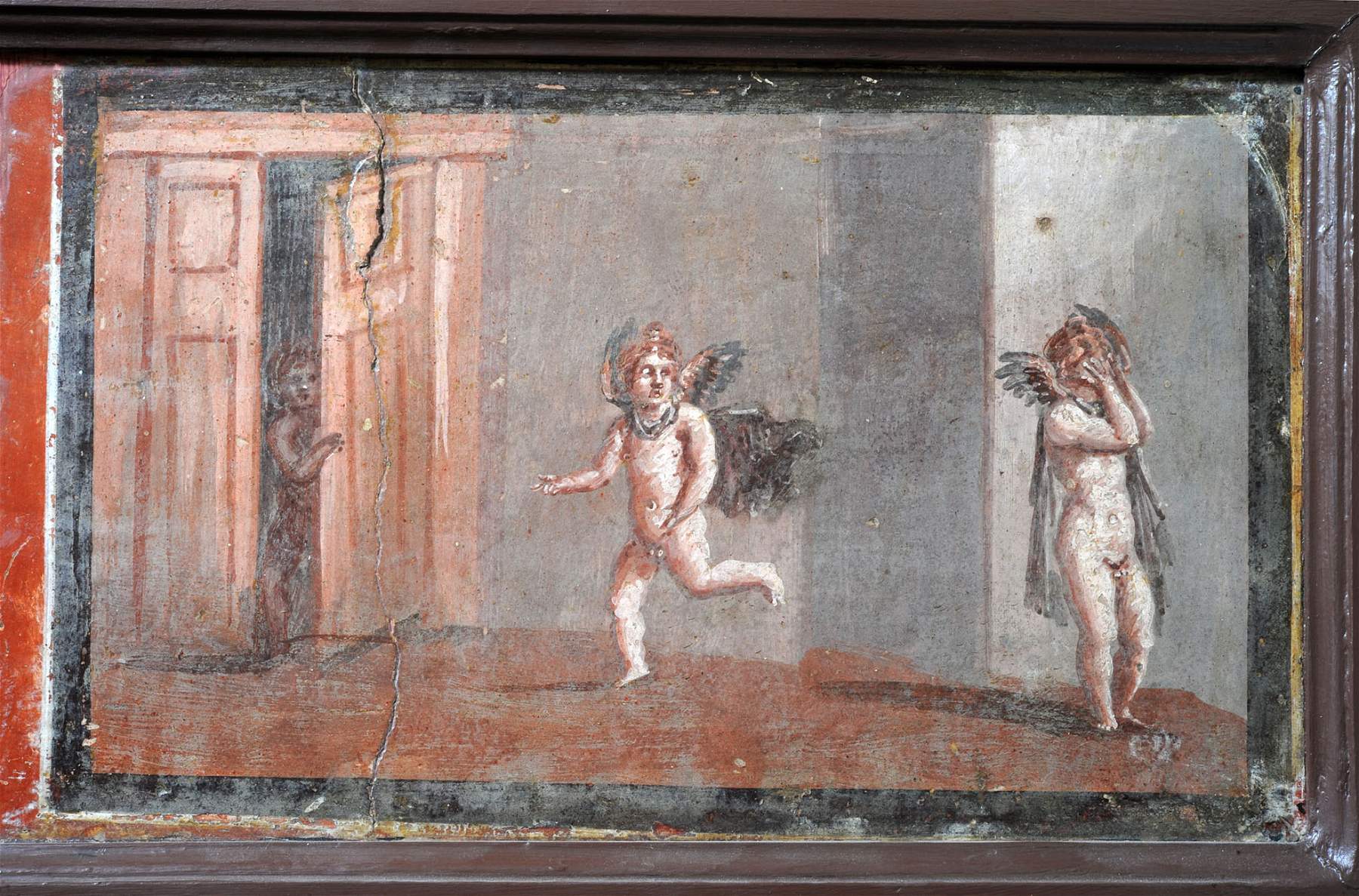At the MANN in Naples, an exhibition on play in antiquity, also featuring contemporary works
An exhibition on play in antiquity in dialogue with the creations, also on the theme of play, of contemporary artists: this is Giocare a regola d’arte, scheduled at the National Archaeological Museum of Naples from December 10, 2021 to June 2, 2022. The exhibition, curated by Paolo Giulierini and Ermanno Tedeschi, is based on an itinerary, set up in the Rooms of the Frescoes, that displays fifty artifacts, selected from the MANN’s storerooms, that dialogue with toys and artistic creations of the contemporary world to illustrate how the childlike nature of our identity has perhaps changed little.
The exhibition is divided into six sections: childhood; boyhood ; simple play; the games that make one grow up; toys; and the games that make one grow up. For each exhibition segment, the common thread is a comparison of forms and modes of amusement, in a marriage between the exhibits and their present-day “counterparts.” The scientific project, which is presented today at the Museum, will be born in 2019 with the exhibition Bimbumbam, play is life, play is memory, play is art, set up at the Steri Complex in collaboration with the University of Palermo; further exhibition pieces, in 2021, were presented at the Museum of Ceramics in Mondovi and the Negev Museum in Be’er Sheva, Israel, always highlighting how playful and artistic activities can take on a formative importance that goes beyond entertainment. The scientific design of the MANN exhibition is by Marialucia Giacco (Archaeological Officer/National Archaeological Museum of Naples); the exhibition design is signed by architect Silvia Neri.
“What better time to open an exhibition on the history of toys than the Christmas holidays?” says Paolo Giulierini, director of the museum. "The MANN has enthusiastically joined this international traveling project that, at each stage, is enriched with new content related to the specificities of the museums that host it. Because play is the magical everyday life of the youngest, but also memory for adults . Here at the Archaeological Museum of Naples Playing in the Artful Way takes us tenderly back to the children of many centuries ago, but also to our childhood and that of our fathers. Putting new generations at the center of programming means making sense of a museum’s mission: at MANN we do this with many free activities, family subscriptions, dedicated publishing, comics and technology. And with small gestures of care, for example the Baby Pit stop for breastfeeding and, above all, involving kids in the big exhibitions with sections like Gladiatorimania. Playfulness is all about them and children of all ages."
“The exhibition is a hymn to play,” says Ermanno Tedeschi. “Play is art. A work of art can be seen as play or represent it; there are many artists in the history of art who have tried their hand at it. We have selected some mostly contemporary artists who play with their tools and through disparate techniques sublimate play into poetic forms. Learning to play means learning to live. Play teaches a method, to make order and teaches to be serious; it teaches the game of life and the rules that determine the characteristics of the adult of tomorrow. Children who do not play are ungrown adults who have not learned to be in society. Rules and play walk together, because there is no play without rules and vice versa.”

The exhibition layout
Rule-based play opens with the section dedicated tochildhood, which is itself divided into two distinct areas: the first is dedicated to the iconographic representation of the world of the little ones, and the second to breastfeeding and the life of the newborn. Present are five statuettes, made of marble and terracotta, which fix certain expressive characteristics of childhood. These MANN artifacts include two kneeling children (from Pompeii, second half of the 1st century AD), an expressive portrait of a little girl (from Sessa Aurunca/ late 1st-2nd century AD), an “adult” child in a toga (from Pompeii, 1st century AD.), as well as the presentation of nine finds including kourotrophos figurines (from Capua, 4th- 3rd century B.C.) and ceramic poppatoi, which also have bold shapes, such as that of a bird (return from the Cleveland Museum of Art/ late 4th- 3rd century B.C.). Space for contemporary creativity, then, with artists such as Carlo Galfione and Francesca Duscià describing, in their canvases, the innocence of infants and their curious gaze to learn about the world; next, Edward Spitz transforms the iconic Mickey Mouse into a tender infant, while Israeli Ami Shinar narrates the very close relationship between an Ethiopian mother and her baby. Then there is the sweet little girl taking a bath with a duck (David Gerstein), or Emilia Faro’s delicate watercolor of a little girl driving a toy car. Even a simple cardboard becomes play for the baby by Sharon Rashbam, while visitors can dream of having fun with Fosca Boggi’s colorful glazed ceramics-the works look so real that they can be mistaken for the originals.
Then we move on to childhood: in this section there are seven ancient works, including three from storage. Necessary to mention is a fresco, depicting a cupid frightening his companions with a mask (from Herculaneum, 1st century B.C.) and a portrait of a prince from the Julio-Claudian age (from Pompeii, House of the Citarist, late 1st century B.C.). With a leap into the contemporary, the audience experiences the dreams of Enrico T. De Paris and Gabriele Turola or the nightmares of Rona Boyarski; also present are the joyful simple games of Michal Lazar, as well as the secrets whispered by the maidens of Margherita Grasselli.
We get into the heart of the theme of play with eight artifacts, including five from the deposits. In these works, the main amusements of ancient children are represented: the game of the nail, in which each of the participants had a nail tied to a string, to be thrown and driven into a mound of sand/earth (the fresco on display comes from Pompeii and is from the first century A.D.);ephedrismòs (a game of piggyback, represented in a Capuan terracotta from the third century B.C.C.); hide-and-seek (the fresco on display is a MANN find from Herculaneum, 1st century A.D.); the kite( red-figure Attic ceramicchous from the Lucanian area, 470-450 B.C.); the hoop game (depicted in a terracotta of uncertain provenance-3rd century B.C.); and bone dice. They are followed, for the games they make grow, by other works in storage: statuettes of gladiators (from Pompeii, 1st century AD) and a fresco depicting cupids playing hide-and-seek and circus races (from Herculaneum, 1st century AD). These artifacts are flanked by depictions of modern players: on display are Antonio Marciano’s gladiators or historical toys from the early 20th century, which testify to how, while having fun, relational networks are built that will lead young children to grow up.
Then there are some toys par excellence from the ancient world: these exhibits include terracotta puppets (from Capua, 4th century B.C.), placed in dialogue with precious dolls from Renata Frediani’s collection and tin toys from the early 20th century. The exhibition also features the contribution made by the first “electronic” toys of the 1950s, chosen by Pompeo Vagliani, director of MUSLI - Museum of School and Children’s Books. Alongside these creations are the works of performers who used games for fun: Ale Piano’s Alterego sculptures or Israeli artist Suly Bornstein Wolff’s Shanghai.
The exhibition concludes with the much-dreaded transition from the world of children to the world of “grown-ups”: this section includes, on the one hand, play with animals, exemplified by a number of artifacts from the deposits, including bronze statuettes, marble figurines, and terracottas. Again, the reference to the contemporary is enriched by meditating on the ancient roots of disguise: on display here are comic masks (from the Vesuvian area, 1st century AD) and terracotta marionettes with oriental dancers (from the Vesuvian area, 1st century AD). The reference to Pinocchio is inescapable: to be mentioned, in this regard, the painting by Ezio Gribaudo, the embroidered figure by the Israeli Nouli Omer, the sculpture by Paolo Spinoglio or the very precious Pinocchio from the 1930s made of wood, which, although it has some cracks, has not been restored to keep alive the concept of “archaeology of play.” There is no shortage of participatory art time, where the public will be able to complete a modern mosaic thanks to the Pixel Art pegs from Quercetti, a toy factory with an educational imprint, which made Alexander’s face from the world-famous Battle of Issus. The exhibition also has two forays into museum spaces other than those in which the heart of the display is developed: in the Atrium, there is a group of Barbapapa, signed by Giorgio Di Palma; in the Giardino delle Fontane, the colorful installation Ad Ovo: rabbit, hen and hippocampus by Camilla Ancilotto stands out.
For information you can visit the MANN Naples website.

 |
| At the MANN in Naples, an exhibition on play in antiquity, also featuring contemporary works |
Warning: the translation into English of the original Italian article was created using automatic tools. We undertake to review all articles, but we do not guarantee the total absence of inaccuracies in the translation due to the program. You can find the original by clicking on the ITA button. If you find any mistake,please contact us.




























